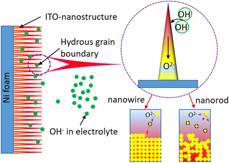Article contents
Indium tin oxide nanowires as voltage self-stabilizing supercapacitor electrodes
Published online by Cambridge University Press: 06 August 2019
Abstract

A supercapacitor electrode featured with a voltage self-stabilizing capability is demonstrated by growing indium tin oxide (ITO) nanowires on Ni foam. The ITO nanowires with a single crystal structure are prepared by using magnetron sputtering technique, and they can act as an active electrode material. Charging–discharging experiments are performed under different current densities, demonstrating a good rate capability. Using properly designing top and bottom double connection circuits, part of the electrode can be used as a resistance switch. An electrode that can function as a supercapacitor and a resistance switch is fabricated. Detailed characteristics confirm that the device not only exhibits high performance as a supercapacitor but also has good characteristics of resistance switching (RS). The specific capacitance is 956 F/g at the scanning rate of 10 mV/s, and the switching ratio as a bipolar resistance switch is as high as 102. The stabilization time of discharging voltage is nearly doubled longer than that without any RS function, revealing the potential application of our devices, which can be used as a supercapacitor with voltage self-stabilizing.
- Type
- Article
- Information
- Copyright
- Copyright © Materials Research Society 2019
References
- 5
- Cited by


